FCR Enterprise-Wide Metric
Most organizational leaders view First Call Resolution (FCR) as a metric that is only applicable to contact centers. However, a small but growing number of organizations have included the FCR metric for enterprise-wide accountability at all levels (e.g., CEO and down). The FCR metric does not apply to all organizations. For example, organizations that do not have a contact center or have call volumes that are low compared to other contact channels.
FCR enterprise-wide metric for accountability at all levels is a worthy question to ponder. SQM Group’s view is that the business case for using FCR as an enterprise-wide metric for accountability at all levels is strong.
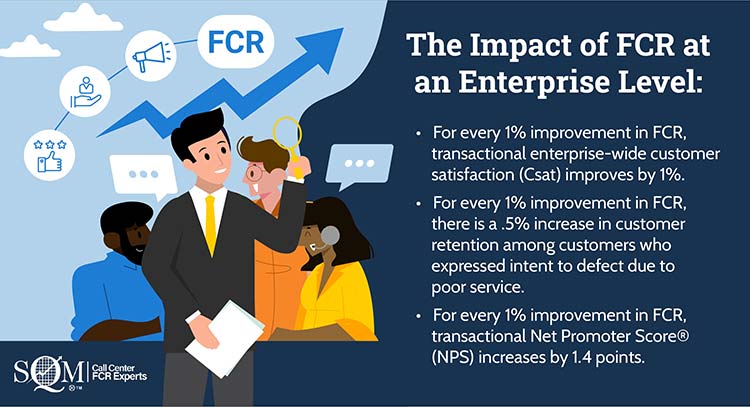
Providing FCR is central to positively impacting operating costs, Csat, and NPS at the enterprise-wide level. Organizations that use FCR as an enterprise-wide metric treat FCR as more than just a metric; FCR is an operating philosophy. They have incorporated the "FCR operating philosophy" into their core people, processes, and technology operating practices to ensure that they are focused on delivering FCR by creating accountability for FCR goals at all levels.
Organizations that use the FCR metric to create accountability for all positions and levels within an organization are highly committed to delivering a great customer experience (CX). Some organizations show how serious they are about FCR by tying an enterprise-wide annual bonus to FCR goal results. It is not uncommon for organizations to have up to a 20% yearly bonus payout for FCR performance involving everyone from the CEO down to the frontline employees.
There is a compelling argument to be made around attaining the strategic alignment of enterprise-wide goals. When the entire organization is aligned on the right common metrics, there are fewer competing goals. To create alignment of goals across the organization, some of them are discovering that it is most effective to leverage FCR at the enterprise level since all employees can influence FCR. In contrast, only select employees can influence other enterprise-wide metrics (e.g., NPS).
Many organizations have used NPS as an enterprise-wide metric successfully. However, NPS has been very controversial at the contact center level since it is a metric that is very broad and has far-reaching influences across the organization. Furthermore, many contact center leaders believe that transactional NPS is not an appropriate metric because they have no control over price, policies, products, and promotions.
FCR is a metric that is a more impactful metric that all employees can be held accountable to and delivers real insights into an organization’s efficiency and effectiveness. When you determine your FCR performance from a customer perspective, you gain actionable insights into improving the business outcome metrics (e.g., operating costs, Csat, and NPS).
Relationship Between Leading and Lagging CX Metrics
Figure 1 shows the relationship between leading and lagging metrics based on CX when calling a contact center. Based on contact center CX, SQM’s research shows that call resolution and FCR are leading indicators for operating costs, Csat, and NPS enterprise-wide metrics. Put simply, for customers to continue to do business with or recommend the organization, their contact center must achieve high levels of call resolution and FCR performance.
When the First Contact Resolution rate is high or low for many organizations, so are the enterprises operating costs, Csat, and NPS metrics. Put differently, your First Contact Resolution rate is the pulse of your organization’s effectiveness and efficiency. The bottom line for many organizations is that operating costs, Csat, and NPS enterprise-wide KPIs cascade from First Contact Resolution.
FIGURE 1: LEADING AND LAGGING METRICS
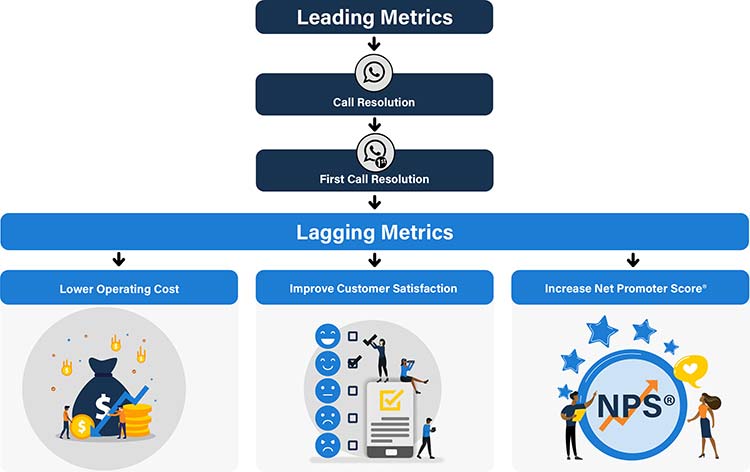
Business Case for Using FCR as an Enterprise-Wide Metric
Now let's look at the business case data for making FCR an enterprise-wide metric.
The Cost of Non-First Call Resolution
Figure 2 shows the cost of non-FCR. The data reveals that the average contact center resolves 70% of their calls on the first call. This means that 30% of customers have to call back because their issue is not resolved on the first call. For the average contact center that SQM benchmarks, the number of repeat calls made to resolve a customer’s initial inquiry or problem is approximately 540,702, representing 26% of the annual call volume, and costs the average contact center about 4.8 million dollars per year. World class FCR (i.e., 80% or better FCR performance) contact centers’ repeat calls are only between 10% and 15% of total call volume.
The cost-saving opportunities for improving FCR are tremendous for contact centers but small in comparison to enterprise-wide cost savings to improve FCR and decrease customer defections. You can make a legitimate argument that the FCR rate reflects an enterprise’s operating cost efficiency and effectiveness from a customer perspective.
FIGURE 2: COST OF NON-FCR
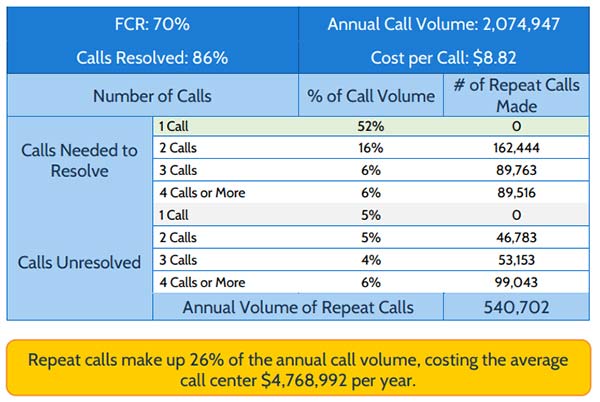
Research shows that it costs five times more to acquire a new customer than to retain an existing one. Many organizations focus on retaining customers to avoid high customer acquisition costs. However, it’s a well-established fact that most organizations emphasize customer acquisition more than they do on customer retention. The improvement of FCR can lead to enterprise-wide level operational savings. The increased cost savings at the enterprise-wide level are primarily due to reducing customer defection costs by improving the FCR rate. Figure 3 shows the impact of FCR and call resolution on customer defections.
SQM research reveals that only 5% of customers expressed their desire to stop doing business with a company when FCR is achieved. Furthermore, for every 1% improvement in FCR, there is a .5% increase in customer retention among customers who expressed intent to defect due to poor service. However, when it took two or more calls to resolve an inquiry, 9% of customers expressed their intent to defect, and an alarming 25% of customers expressed their intent to defect if their call was unresolved. Most organizations do not know which customer’s call goes unresolved.
According to Reichheld (1996), “In general, the longer a customer stays with a company, the more that customer is worth. Long-term customers buy more, take less of a company’s time, are less sensitive to price, and bring in new customers. Best of all, they have no acquisition or start-up cost. Long-term customers are worth so much that in some industries, reducing customer defections by as little as five points – from, say, 15% to 10% per year – can double profits.”
FIGURE 3: IMPACT OF FCR AND CALL RESOLUTION ON CUSTOMER DEFECTIONS

First Call Resolution Impact on Enterprise-Wide Customer Satisfaction
First Call Resolution positively impacts contact center and enterprise-wide Csat. SQM’s research shows that for every 1% improvement in FCR, there is a 1% improvement in contact center Csat. Furthermore, our research shows that on average, Csat (top box response) drops 15% every time a customer has to call back to resolve their initial call.
Figure 4 shows the impact of FCR on transactional enterprise-wide Csat. When FCR is achieved, Csat is 78%, and when repeat calls are required to resolve an inquiry or problem, Csat drops to 64%. However, if the call is unresolved based on only one call, Csat drops to 46%, but what is truly alarming is if an inquiry or problem is unresolved based on two or more calls, Csat drops to a dismal 29% level. The absence of FCR is a strong driver of transactional enterprise-wide customer dissatisfaction.
Most organizations or contact centers do not track if a customer transaction in doing business with an organization is unresolved from a customer perspective. Given the enormous negative impact that unresolved calls have on Csat, there is a tremendous opportunity to measure FCR and call resolution more effectively from a customer’s perspective to determine contact center and enterprise-wide Csat impact.
FIGURE 4: IMPACT OF FCR AND CALL RESOLUTION ON CUSTOMER SATISFACTION
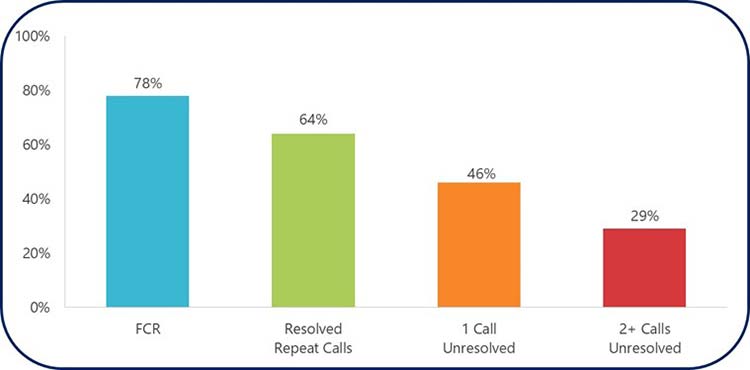
First Call Resolution Impact on Transactional NPS®
First Call Resolution positively impacts transactional NPS. SQM’s research shows that every 1% improvement in FCR increases transactional NPS® by 1.4 points for the average contact center. FCR and transactional NPS have a statistical correlation of .64, which would be considered high and shows that FCR positively impacts transactional NPS.
Many contact center leaders believe that transactional NPS is not an appropriate metric because they have no control over enterprise-level pricing, policies, products, and promotions. Conversely, many non-contact center employees believe that FCR is not a relevant metric because they have no control over contact center operating practices. But is that the correct way to view the FCR metric?
For many organizations, the contact center is the primary contact channel customers use to interact with them. Suppose your contact center is the main contact channel customers use. In that case, you should consider making FCR an enterprise-wide metric for which all employees at all levels are held accountable. However, as previously mentioned, FCR is not applicable as an enterprise-wide metric to hold all employees responsible for when an organization does not have a contact center or have call volumes that are low compared to other contact channels.
Figure 5 shows SQM's contact center research of the impact that FCR, Repeat Calls, and Calls Unresolved have on transactional NPS. The data reveals that when customers experience FCR using a contact center, the transactional NPS is 64 points. When an inquiry or problem Call was Resolved, but it took repeat calls, NPS drops to 40 points. When one call took place, and the Call was Unresolved, NPS goes down to -10 points. However, what is most alarming is when two or more calls took place, and the Call was Unresolved, NPS is -38 points. Clearly, FCR is a driver for improving transactional NPS.
FIGURE 5: IMPACT OF FCR AND CALL RESOLUTION ON TRANSACTIONAL NPS
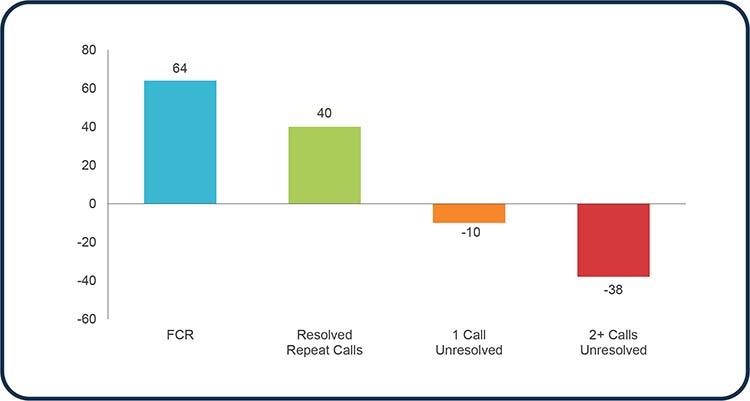
In Closing
As I previously mentioned, using FCR as an enterprise-wide metric for accountability at all levels (e.g., CEO and down) is a worthy point to consider. SQM’s experience is that the FCR metric is limited to contact center leaders and seldom takes place at the enterprise-wide executive level. Our view at SQM Group is that you can make a strong business case for using FCR as an enterprise-wide metric for which all employees at all levels are held accountable. The key is to gather FCR impact data on business outcome metrics (e.g., operating costs, Csat, and NPS) and share this data with C-level to start the discussion. If you need help determining the FCR business case, contact SQM, we will gladly help you out.
Reference:
Reichheld, F. F. (1996). Learning from Customer Defections.
Quick Related Links
First Call Resolution Definition First Call Resolution PPT First Call Resolution Benefits
First Call Resolution Strategies First Call Resolution Operating Philosophy First Call Resolution Formula Calculate First Call Resolution Rate What Is a Good FCR Rate? One Contact Resolution Channel Hopping


